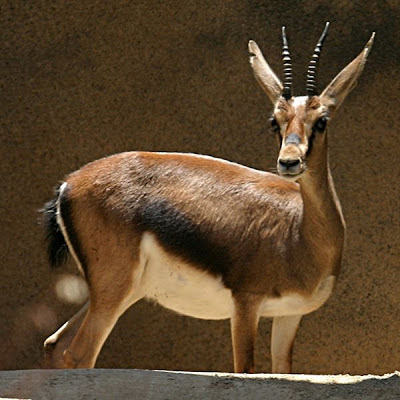When standing in bright sunlight, this Cuvier's gazelle is likely to present an unexpected silhouette to a potential predator.
Countershading is commonly seen in marine animals such as fish as well, darker on the dorsal surfaces and lighter on the ventral surfaces.
Since both predators and prey need to remain hidden, both are frequently countershaded. Penguins and killer whales evolved from very different terrestrial ancestors, and both developed a similar black and white pattern of countershading.
Countershading is mentioned in Imaginative Realism










7 comments:
This reminded me of the countershading camouflage used on some world war II aircraft, clearly following the same principle. Great post!
I've been drawing animals for years...never thought of why the belly is a different shade from the rest of the body..thanks James!
It does mean that when painting the creature, the underneath shade colour needs to be carefully considered. It can be quite tricky if the body colour extends underneath too. You need two 'shade' tonal ranges, not just one. I haven't expressed myself clearly, but I know what I mean! :-)
Of course it all gets modified by the bounce of light off the ground too...
Amazing. This morning I red the same facts in your book "Imaginative realism" James. I really like it - its extremely helpful.
I always assumed that the top was darker due to protective pigmentation as a defense from the sun, and camouflage. fun post! -RQ
So countershading disguises due to the fact it breaks up their (profile) silhouette making them harder to recognize?
Similar to zebras stripes (in a group) serving a similar purpose where it is hard to see one individual animal?
oh - nice to read that here!i just read about countershading in a book from arnheim the other day - he also mentioned that the reason why their upper back is often darker than the bottom (for rats/mice as well as antilopes you mentioned) is, so they cannot be recognized/seen that good from above (well, that maybe isn't that relevant for antilopes)
i'm currently writing my bachelorsthesis about colour and light in pictoral design (but mostly according to the old masters) - it's extremely interesting, and your two books are on my literature as well of course (actually, color and light was the one where i got much of the other literature from)
it would be really great, if i may get back to you if i'm stumbling across some questions!
aaand - obligatory - your blog is so amazing, thanks for sharing that much useful information! i'm reading over every article you're writing (:
Post a Comment